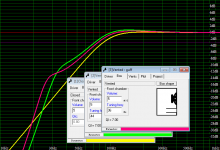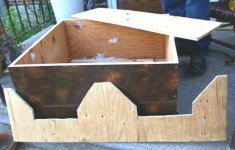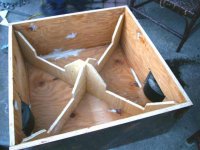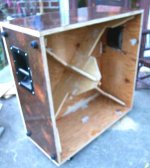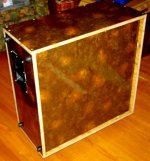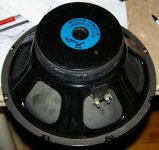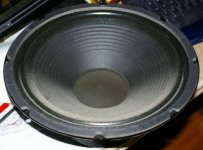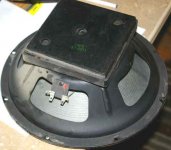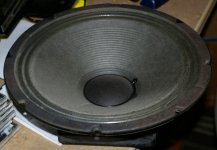For that sound, 4 x 10 bass guitar speakers in a sealed cabinet. I don't hear anything below 100hz or so. There are no bottom two octaves. Forget about 30hz. Traditionally, bass cabinets never go that low, and if they do, you will have problems. They often start rolling off around 100. You are hearing the harmonics of those notes in the video, with very little fundamental.
Using a sealed cabinet will make the bass response roll off more gradually as it goes deeper, which will generally sound 'tighter' in a room.
BTW guitar speakers tend to have a high Fs of around 100. They're like big midranges. Bass speakers are essentially PA drivers, with a lower Fs and more excursion.
I guess I'm basically agreeing with chriss661's post, even if it isn't obvious... 😉
Using a sealed cabinet will make the bass response roll off more gradually as it goes deeper, which will generally sound 'tighter' in a room.
BTW guitar speakers tend to have a high Fs of around 100. They're like big midranges. Bass speakers are essentially PA drivers, with a lower Fs and more excursion.
I guess I'm basically agreeing with chriss661's post, even if it isn't obvious... 😉
Last edited:
Hi,
It is going round in circles, so might a well throw in a curve ball :
Madisound Speaker Store
Buy 30 and build a 4x4 into your cabinet. Add bracing to the front panel,
oversize its driver cutouts, and a thinner front panel to mount the drivers.
(easier than chamfering cutouts). $320 worth of drivers for $60.
Plenty of excursion, > +/-6mm, 320W continuous, 101dB/W 8 ohms.
If you have a 4 ohm amplifier you could build another 4 series x 3 row parallel
extension cabinet of about 3 cuft sealed with the other drivers, and that would
take you up to to about 103dB/realW and 106dB/4ohmW.
At around 100dB/W this is what all cabinets of 5 cuft will ~ look like.
build it with 3 ports, tuned to 44Hz, and block one for low B use.
rgds, sreten.
It is going round in circles, so might a well throw in a curve ball :
Madisound Speaker Store
Buy 30 and build a 4x4 into your cabinet. Add bracing to the front panel,
oversize its driver cutouts, and a thinner front panel to mount the drivers.
(easier than chamfering cutouts). $320 worth of drivers for $60.
Plenty of excursion, > +/-6mm, 320W continuous, 101dB/W 8 ohms.
If you have a 4 ohm amplifier you could build another 4 series x 3 row parallel
extension cabinet of about 3 cuft sealed with the other drivers, and that would
take you up to to about 103dB/realW and 106dB/4ohmW.
At around 100dB/W this is what all cabinets of 5 cuft will ~ look like.
build it with 3 ports, tuned to 44Hz, and block one for low B use.
rgds, sreten.
Attachments
Last edited:
Okay, I thought I'd better post the build so far,
so I can get comments on the carpentry side:
I came up with a real strong front/back support scheme:
The St.Andrews cross-diagonals.
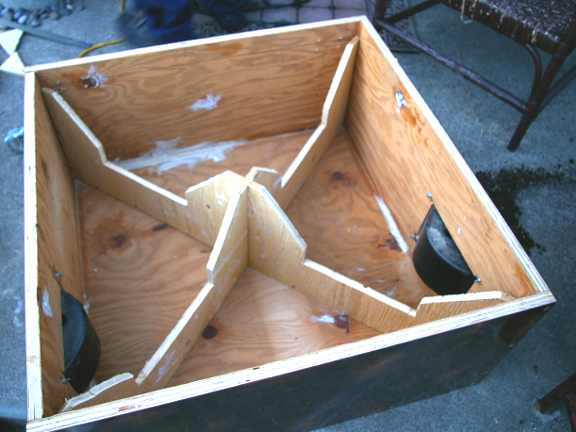
This is like the Greek-cross idea, but actually better I think,
because it doesn't divide up the back resonating drum-head
into smaller drumheads.
Instead, the triangular shapes quickly dampen and kill resonances
and turn standing waves into quiet heat.
Also, the cross supports the front panel in five places, including
the front center, the most important zone. I am also toying with
adding 2x4 or 2x2 struts at 12 o-clock, 3 oclock, 6 oclock and 9 oclock,
about half-way from center, to further support the front-panel at its weakest points.
As well, there will be a supporting rim (probably 2x2 (1.5 really)) running the inside perimeter.
There will also be diagonal treatments of the for sides/top/bottom, to triangulize and deaden those.
Finally, I will add heavy felt on the sides and foam the corners
and stuff the cabinet with medium weight pillow/comforter fluff.
What think ye?
Now is the time to make construction suggestions.
The back, sides, front are all 1" plywood covered with counter-top laminate.
My friend at the speaker shop suggested avoiding wheels, for a bass cab.
So I came up with this ingenious idea: Put wheels on bottom (relative to handles)
and put rubber feet on side (flip on side for playing)!
Ta Da! see picture 3.
so I can get comments on the carpentry side:
I came up with a real strong front/back support scheme:
The St.Andrews cross-diagonals.

This is like the Greek-cross idea, but actually better I think,
because it doesn't divide up the back resonating drum-head
into smaller drumheads.
Instead, the triangular shapes quickly dampen and kill resonances
and turn standing waves into quiet heat.
Also, the cross supports the front panel in five places, including
the front center, the most important zone. I am also toying with
adding 2x4 or 2x2 struts at 12 o-clock, 3 oclock, 6 oclock and 9 oclock,
about half-way from center, to further support the front-panel at its weakest points.
As well, there will be a supporting rim (probably 2x2 (1.5 really)) running the inside perimeter.
There will also be diagonal treatments of the for sides/top/bottom, to triangulize and deaden those.
Finally, I will add heavy felt on the sides and foam the corners
and stuff the cabinet with medium weight pillow/comforter fluff.
What think ye?
Now is the time to make construction suggestions.
The back, sides, front are all 1" plywood covered with counter-top laminate.
My friend at the speaker shop suggested avoiding wheels, for a bass cab.
So I came up with this ingenious idea: Put wheels on bottom (relative to handles)
and put rubber feet on side (flip on side for playing)!
Ta Da! see picture 3.
Attachments
Last edited:
Also for reference, here are the speakers I cobbled from two dead amps:
(1) Fender Special Design (?) 12" (2 speakers from a Pro-185; Transistor version of a Twin).

(2) Traynor OEM Square Magnet 12" (2 speakers from a TS-100, again a transistor version of a Twin clone).
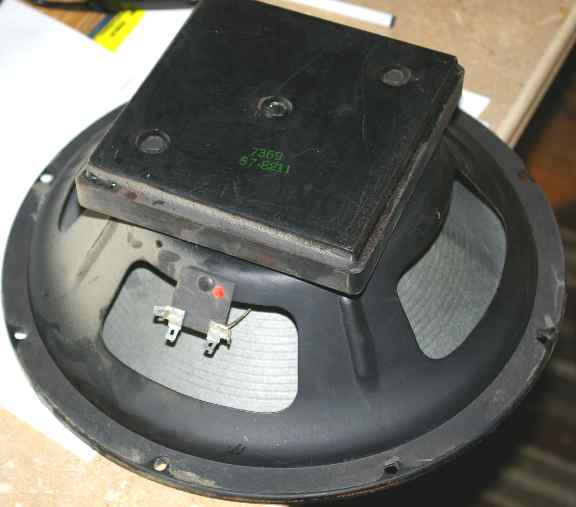
They seem to be both about the same wattage (50? 100?),
and both to be bona fide heavy duty guitar speakers.
They were both in open backed cabinets,
and I guess the only concern is that if mounted in a closed back cabinet,
that the accordion surrounds won't get damaged from air pressure punching holes in them.
Someone said that open-back speakers don't last long in closed cabs.
But is this true for larger cabs too?
The serial number on the Traynor is 7369 67-8211,
and somewhere someone claimed that these were made for Traynor in /73 by Eminence(?)
Another person backed up the Eminence claim with some details:
Another person claimed they were made by CTS in /82:
as people here have mentioned that you need the three important specs to design a cab properly:
i.e., Fs Xmax, etc.
It would be great even if someone could guesstimate the real RMS wattage of these things.
(1) Fender Special Design (?) 12" (2 speakers from a Pro-185; Transistor version of a Twin).

(2) Traynor OEM Square Magnet 12" (2 speakers from a TS-100, again a transistor version of a Twin clone).

They seem to be both about the same wattage (50? 100?),
and both to be bona fide heavy duty guitar speakers.
They were both in open backed cabinets,
and I guess the only concern is that if mounted in a closed back cabinet,
that the accordion surrounds won't get damaged from air pressure punching holes in them.
Someone said that open-back speakers don't last long in closed cabs.
But is this true for larger cabs too?
The serial number on the Traynor is 7369 67-8211,
and somewhere someone claimed that these were made for Traynor in /73 by Eminence(?)
Identify these 12"s?
An externally hosted image should be here but it was not working when we last tested it.by chille on Tue Feb 07, 2006 4:09 am
Just bought a Traynor G3-412 cab from the 70's, and it has two different sets of speakers in it. I'm new to identifying speakers, so if anyone has a good online resource I'm all ears. I don't know what the cab might have originally had, so I don't know if it has been reloaded or not. Here are the identifying features:
Set 1: Code printed just like this on magnet: 13-32
67 7327
-Square, black magnet
-Black frame
-Black or possibly dark green back of cone (hard to tell, looks different in different light)
-grey or faded black front of cone
-biege outside front edge
A: The square-magnet speakers are Eminence units from 1973. Don't know about the others, maybe Norelco??
Another person backed up the Eminence claim with some details:
"eminence makes some great speakers, and I think are the largest OEM mfr for gtr amps
if you can find any numbers or codes on the speaker or cone, that would help
emi part #'s start with 67 I think...if that's the case you can email them & they'll give you any info they have
OEM means they build speakers to mfr specs ( fender, traynor, etc ), so if the mfr specs out a crappy, cheap speaker, it'll be a crappy, cheap speaker."
Another person claimed they were made by CTS in /82:
I would like to get info on both these speakers,"Attn: all Traynor buffs,
I have four CTS square magnet speakers that I took out of a Traynor 4x12 cabinet (circa 1982) which I'm going to sell."
as people here have mentioned that you need the three important specs to design a cab properly:
i.e., Fs Xmax, etc.
It would be great even if someone could guesstimate the real RMS wattage of these things.
Attachments
Last edited:
I think CTS (Chicago Telephone Supply) is a red herring. They did make square magnet speakers, but these seem to be silver, and the baskets look different:
Here are two CTS 12" guitar speakers:


Here's a pic with the CTS logo clearly visible:

CTS made 15" with the same style square magnets:
Notice the screws are on the sides and not the corners of the square.
But now for the stumper!
Eminence seems to have bought the same speaker from CTS, and branded it as its own:

The basket looks identical.
Did CTS make it for Eminence, or did Eminence make it for CTS?
Just to make it more interesting,
Fender bought some from either CTS or Eminence, and branded it as their own:

Oddly, the Ampeg History page says that Ampeg used CTS speakers until 1971, then switched to Eminence:
or Eminence took over supplying both CTS and everyone else...
I notice a time-marker in the type of screws used in assembly:
The early CTS are using Flatheads (which were awful early designs),
and the Eminence has Philips (developed by Philips for industry),
and the Fenders have even newer Philips and also flatheads too! (painted/baked enameled).
I note that the Traynor version sports its own screws, with Hexagonal 'nut' style heads!
Looks like the square magnets were a cheap solution to quickly providing
higher power speakers to the blooming guitar amp markets,
and were cheaper to make (no added rounding / shaping of materials.)
Here are two CTS 12" guitar speakers:
Here's a pic with the CTS logo clearly visible:

CTS made 15" with the same style square magnets:
An externally hosted image should be here but it was not working when we last tested it.
Notice the screws are on the sides and not the corners of the square.
But now for the stumper!
Eminence seems to have bought the same speaker from CTS, and branded it as its own:

The basket looks identical.
Did CTS make it for Eminence, or did Eminence make it for CTS?
Just to make it more interesting,
Fender bought some from either CTS or Eminence, and branded it as their own:

Oddly, the Ampeg History page says that Ampeg used CTS speakers until 1971, then switched to Eminence:
If so, then either there were still warehouses full of CTS speakers that CTS wanted to dump (e.g. onto Traynor),"The CTS speakers give way to Eminence drivers around 1972.
In 1980, Ampeg designers install new speakers which give the cabinet
a power handling rating of 350 watts."
or Eminence took over supplying both CTS and everyone else...
I notice a time-marker in the type of screws used in assembly:
The early CTS are using Flatheads (which were awful early designs),
and the Eminence has Philips (developed by Philips for industry),
and the Fenders have even newer Philips and also flatheads too! (painted/baked enameled).
I note that the Traynor version sports its own screws, with Hexagonal 'nut' style heads!
Looks like the square magnets were a cheap solution to quickly providing
higher power speakers to the blooming guitar amp markets,
and were cheaper to make (no added rounding / shaping of materials.)
Last edited:
Well, in any case, one thing seems to be coming in loud and clear:
Guitar speakers are simply not suitable for Bass,
and using a guitar speaker to reproduce bass will not reproduce bass,
and will likely damage the guitar speaker.
I am quite willing to accept this, since it appears based on real scientific principles and evidence.
On the other hand, I still have this cabinet half-built,
and four guitar speakers. I suppose I could put them all in there,
and just use the cabinet for guitar (option A).
The other option also looks very attractive:
Namely putting four 10" speakers in this cabinet,
making it a closed box, and maybe adding a bullet tweeter,
and using it for Bass only.
This would take advantage of the heavy 1" plywood construction (probably overkill for guitar).
Finally, the suggestions to keep the guitar speakers in pairs,
and built maybe two OTHER cabinets looks very good too,
since these speakers are heavy, and maybe four of them would be too loud and too heavy to move around!
Two smaller cabinets, as recommended, with say 4 cubic feet in each, and two speakers in each, would also avoid mismatching the two pairs of speakers (they obviously do match in pairs, but maybe not as four together).
I'd then have two guitar cabinets (2 x 12") and one bass cab (4 x 10")
The next question would be, would it be worthwhile to port the guitar speaker cabinets, or as someone suggested seal them too as closed cabinets?
Guitar speakers are simply not suitable for Bass,
and using a guitar speaker to reproduce bass will not reproduce bass,
and will likely damage the guitar speaker.
I am quite willing to accept this, since it appears based on real scientific principles and evidence.
On the other hand, I still have this cabinet half-built,
and four guitar speakers. I suppose I could put them all in there,
and just use the cabinet for guitar (option A).
The other option also looks very attractive:
Namely putting four 10" speakers in this cabinet,
making it a closed box, and maybe adding a bullet tweeter,
and using it for Bass only.
This would take advantage of the heavy 1" plywood construction (probably overkill for guitar).
Finally, the suggestions to keep the guitar speakers in pairs,
and built maybe two OTHER cabinets looks very good too,
since these speakers are heavy, and maybe four of them would be too loud and too heavy to move around!
Two smaller cabinets, as recommended, with say 4 cubic feet in each, and two speakers in each, would also avoid mismatching the two pairs of speakers (they obviously do match in pairs, but maybe not as four together).
I'd then have two guitar cabinets (2 x 12") and one bass cab (4 x 10")
The next question would be, would it be worthwhile to port the guitar speaker cabinets, or as someone suggested seal them too as closed cabinets?
maybe a possible solution?
how about using 2 of the guitar speakers, then using the other two spaces for 10 or 12 inch bass guitar speakers. If u wire up 2 input jacks, one for each pair. Get 16 ohm if poss and wire each pair in parallel unless your amp is find with a 4 ohm load. Then make a shorted out jack plug. Use this plug in the guitar input jack when the amp is powering the bass pair, to protect the guitar speakers from over excursion.
how about using 2 of the guitar speakers, then using the other two spaces for 10 or 12 inch bass guitar speakers. If u wire up 2 input jacks, one for each pair. Get 16 ohm if poss and wire each pair in parallel unless your amp is find with a 4 ohm load. Then make a shorted out jack plug. Use this plug in the guitar input jack when the amp is powering the bass pair, to protect the guitar speakers from over excursion.
I use my 4x10" cab for guitar, too.
Sounds good, just needs boost in the 2-5kHz range. Depending on the speakers you use, you may or may not need this - it'd be easy enough to implement at line-level in the amplifier, anyway: just add a bypass switch so you can go between guitar and bass.
Chris
PS - when using a bass rig for guitar, I've found there's plenty of "oomph" - they never sound thin.
Sounds good, just needs boost in the 2-5kHz range. Depending on the speakers you use, you may or may not need this - it'd be easy enough to implement at line-level in the amplifier, anyway: just add a bypass switch so you can go between guitar and bass.
Chris
PS - when using a bass rig for guitar, I've found there's plenty of "oomph" - they never sound thin.
i used my hartke bass cab with its original drivers and its nearly bright enough due to the wide range of the Al coned 10" drivers. After replacing them with celestion 4G10R the cab sounded mistuned. The port really muddled the lows, despite the fs of 80hz jhese do have weight to their sound, but the fullness of the bloated bass was nicely tempered by adding a couple of pillows and blocking the port with foam. The cab is the usual 4x10 size, 3ft square by 18 inch deep.
hmm this gives me another idea;
Imagine you have actual individual speaker covers (1" thick plywood).
Any pair of speakers could share the whole cabinet (closed, 5 cu. ft.).
But the two speakers not being used
would be covered by a front plate, so effectively,
not only are they not hooked up (two separate jacks, one for each pair),
but also they are not 'in the loop' as passive radiators either.
Now say you cover up the guitar-speakers with the front-plate, but leave the two bass speakers uncovered:
You plug into the bass jack, and they pump the sound,
but they get to use the whole 5 cubic feet,
while the guitar speakers are more or less protected,
because there is an air-pocket trap between them
and the front-plate, so they can't move much.
The trapped air in front of the unused speakers
would act as a kind of 'progressive surround',
and/or shock absorber to keep the excursion of the guitar speakers low, even when the bass speakers are pumping.
Conversely, when you are plugging into the guitar input,
and wailing out heavy high-speed midrange and upper,
the bass speakers are plugged up and covered,
so that the guitar speakers get the whole cab too,
but the bass speakers are kept semi-inert.
Now suppose on a small gig you want to use both sets of speakers at once.
Now you slide in a barrier that divides the cab.
The guitar speakers are on one side, no problem,
except they are in a small box,
but the bass speakers better be 10" so that they can deliver bass,
even with only 2.5 cu.ft. to use.
That could be a useable combo at lower volumes anyway.
Now you have 3 options:
(1) 2 x 12" guitar cab (5 cu.ft) (or insert divider and use only 2.5).
(2) 2 x 12" bass cab (5 cu. ft)
(3) combo 2 x 12" guitar and 2 x 10" bass (divide cab).
The divider could be slid in from top or side, or maybe hinged inside, and pull with rope or lever.
Imagine you have actual individual speaker covers (1" thick plywood).
Any pair of speakers could share the whole cabinet (closed, 5 cu. ft.).
But the two speakers not being used
would be covered by a front plate, so effectively,
not only are they not hooked up (two separate jacks, one for each pair),
but also they are not 'in the loop' as passive radiators either.
Now say you cover up the guitar-speakers with the front-plate, but leave the two bass speakers uncovered:
You plug into the bass jack, and they pump the sound,
but they get to use the whole 5 cubic feet,
while the guitar speakers are more or less protected,
because there is an air-pocket trap between them
and the front-plate, so they can't move much.
The trapped air in front of the unused speakers
would act as a kind of 'progressive surround',
and/or shock absorber to keep the excursion of the guitar speakers low, even when the bass speakers are pumping.
Conversely, when you are plugging into the guitar input,
and wailing out heavy high-speed midrange and upper,
the bass speakers are plugged up and covered,
so that the guitar speakers get the whole cab too,
but the bass speakers are kept semi-inert.
Now suppose on a small gig you want to use both sets of speakers at once.
Now you slide in a barrier that divides the cab.
The guitar speakers are on one side, no problem,
except they are in a small box,
but the bass speakers better be 10" so that they can deliver bass,
even with only 2.5 cu.ft. to use.
That could be a useable combo at lower volumes anyway.
Now you have 3 options:
(1) 2 x 12" guitar cab (5 cu.ft) (or insert divider and use only 2.5).
(2) 2 x 12" bass cab (5 cu. ft)
(3) combo 2 x 12" guitar and 2 x 10" bass (divide cab).
The divider could be slid in from top or side, or maybe hinged inside, and pull with rope or lever.
The guy that founded Eminence was originally an engineer at CTS, and remained friendly with them. They sourced magnets and other parts from the same places. There's more to the story but that's all I know.
Anyhow, nothing is ever simple. Guitar speakers from this era were often slightly redesigned PA drivers, and they might very well work fine for bass. Those drivers you posted seem to be of this type. Cloth surrounds instead of paper is a good sign. I'm running some old eminence alnico PA/guitar speakers myself. (PA speakers and bass guitar speakers are basically the same.) It would be very useful if you could measure the specs. It isn't that hard to do. There are tutorials on the web somewhere.
IMO since you have them, plug 'em in and try. It's possible they won't go quite as deep in the bass as you'd like, but maybe they do and sound great. Worst case scenario is they won't take a lot of power and they blow out cuz you're trying to feed them 1000w.
AFA the convertible idea with sliding covers. Creative thinking, but really dumb. 😉 It's wasted space, you're throwing out half your SPL capability, and it won't protect the drivers much, especially since you'd need to double your power to get the same level as 4 speakers.
Construction looks good. IMO don't get carried away with damping, it makes the sound dull and lifeless. I would start with some carpet felt on the back only, and see how that sounds before stuffing the bejeezus out of it.
One more thing, you'd be cursing your 'friend' who told you not to put wheels on the cab if you ever gig with this thing and it didn't have wheels. Trust me.
Anyhow, nothing is ever simple. Guitar speakers from this era were often slightly redesigned PA drivers, and they might very well work fine for bass. Those drivers you posted seem to be of this type. Cloth surrounds instead of paper is a good sign. I'm running some old eminence alnico PA/guitar speakers myself. (PA speakers and bass guitar speakers are basically the same.) It would be very useful if you could measure the specs. It isn't that hard to do. There are tutorials on the web somewhere.
IMO since you have them, plug 'em in and try. It's possible they won't go quite as deep in the bass as you'd like, but maybe they do and sound great. Worst case scenario is they won't take a lot of power and they blow out cuz you're trying to feed them 1000w.
AFA the convertible idea with sliding covers. Creative thinking, but really dumb. 😉 It's wasted space, you're throwing out half your SPL capability, and it won't protect the drivers much, especially since you'd need to double your power to get the same level as 4 speakers.
Construction looks good. IMO don't get carried away with damping, it makes the sound dull and lifeless. I would start with some carpet felt on the back only, and see how that sounds before stuffing the bejeezus out of it.
One more thing, you'd be cursing your 'friend' who told you not to put wheels on the cab if you ever gig with this thing and it didn't have wheels. Trust me.
The guy that founded Eminence was originally an engineer at CTS, and remained friendly with them. They sourced magnets and other parts from the same places. There's more to the story but that's all I know.
Thanks this really fills out the picture.
The only real thing of interest after this,
is the actual details on various speakers used in cabs in the 60s-80s.
That might help in deciding how to use the ones I have.
Well it would be great if the old Traynors were really PA/Bass speakers, but I'm not holding my breath for this.Anyhow, nothing is ever simple. Guitar speakers from this era were often slightly redesigned PA drivers, and they might very well work fine for bass. Those drivers you posted seem to be of this type. Cloth surrounds instead of paper is a good sign. I'm running some old eminence alnico PA/guitar speakers myself. (PA speakers and bass guitar speakers are basically the same.)
I will examine the surrounds more closely.
I think the Fenders are well reinforced,
but since this amp wasn't that old,
and they were in an open-back (twin) cab,
I doubt they are really bass/PA speakers.
More likely they are 'special' because Fender
got someone like Eminence to make them to their specs.
(i.e., guitar, not bass).
This is probably like fixing my car.It would be very useful if you could measure the specs. It isn't that hard to do. There are tutorials on the web somewhere.
I had to be prodded into it by someone who knew how first,
then I got the confidence to try fixing all kinds of things on my own later.
That is a worst case scenario.IMO since you have them, plug 'em in and try. It's possible they won't go quite as deep in the bass as you'd like, but maybe they do and sound great. Worst case scenario is they won't take a lot of power and they blow out cuz you're trying to feed them 1000w.
I'm not in the ballpark for blowing up speakers for experiment.
too poor for that: I'd rather read about someone else doing it.
Like driving a car into a tree:
Not everyone needs to do it, to figure out its dumb.
You may be right about this bit of creativity not being realistic.AFA the convertible idea with sliding covers. Creative thinking, but really dumb. 😉 It's wasted space, you're throwing out half your SPL capability, and it won't protect the drivers much, especially since you'd need to double your power to get the same level as 4 speakers.
Certainly with guitar speakers I'd need to double power through two speakers to get same volume,
but I don't know if you've thought out my idea properly:
The idea is that for the bass, you use two 12" instead of four 10".
So You aren't really decreasing the square inches of cone,
instead you are halving the number of cones while increasing the cone-size.
Of course you'd need two higher power speakers vs. four lower power ones.
But I think 2 x 12" in 5 cubic feet would be real close to 4 x 10" .
maybe someone could help me here on this,
and tease out the differences.
This is an interesting point,Construction looks good. IMO don't get carried away with damping, it makes the sound dull and lifeless. I would start with some carpet felt on the back only, and see how that sounds before stuffing the bejeezus out of it.
but are you talking about guitar or bass?
I can understand how you might want the cabinet to be 'lively' for guitar, generating some resonances and harmonic distortion.
But with bass I want the opposite here:
NO resonances or peaks or unevenness on my fretboard.
And any harmonic content or 'distortion' I would want to add in the preamp / effects-pedal stage, not in the bass cab.
I agree with you here.One more thing, you'd be cursing your 'friend' who told you not to put wheels on the cab if you ever gig with this thing and it didn't have wheels. Trust me.
Thats why I came up with the idea of keeping the wheels
and just adding rubber feet on one side.
Genius, or just common sense?
or maybe both...😀
Well, while playing with Amazon I came across this apparent bargain:
$39.00 ea
10" Steel Frame Speaker Driver
I don't know about the real wattage rating,
but they appear to be bass speakers:
4 x 10" should equal 500 watts for about $160, and free shipping too!
(I'm hoping they also mean free to Canada).
Any comments on these speakers?
$39.00 ea
An externally hosted image should be here but it was not working when we last tested it.
- Model #: Seismic Audio - Quake 10
- 10" Woofer/Speaker
- 50 oz Magnet with 2.5" voice coil
- 125 Watts RMS, 250 Watts Peak
- Impedance: 8 Ohms
- Frequency response: 65Hz to 5KHz
- Sensitivity: 98db
- Pressed Steel Chassis
- Paper Cone
- Weight: 9 lbs each
10" Steel Frame Speaker Driver
I don't know about the real wattage rating,
but they appear to be bass speakers:
4 x 10" should equal 500 watts for about $160, and free shipping too!
(I'm hoping they also mean free to Canada).
Any comments on these speakers?
An externally hosted image should be here but it was not working when we last tested it.
Last edited:
On the other hand, if I were to go for just 2 x 12",
these also look like a bargain at
12" Bass woofer 350 watts RMS ( x 2 = 700 watts!)
MCM Professional Woofer
$47.57 ...... ( x 2 = $96.00 unfortunately Plus shipping...)
What looks attractive here is the low frequency spec:
these also look like a bargain at
12" Bass woofer 350 watts RMS ( x 2 = 700 watts!)
MCM Professional Woofer
$47.57 ...... ( x 2 = $96.00 unfortunately Plus shipping...)
An externally hosted image should be here but it was not working when we last tested it.
An externally hosted image should be here but it was not working when we last tested it.
What looks attractive here is the low frequency spec:
- Rigid die cast frame
- Treated paper cone
- Treated cloth accordion surround
- 2.5" high temperature voice coil
- 67oz. vented magnet Specifications:
- Sensitivity: 96dB (W/M)
- Impedance: 8ohm
- Re: 6.3ohm
- Le: 1.20mH
- Frequency response:
- 30Hz~3.2KHz
- Fs: 36.2Hz <----------
- Qts: 0.41
- Qes: 0.48
- Qms: 2.82
- Vas: 121.67 liters
- Xmax: 7.0 mm
- Overall frame diameter: 12.28"
- Required cutout: 11.1"
- Mounting depth: 5.51"
Last edited:
good idea. That was the purpose of the shorted jack plug idea. U should use a shorted jack when transporting a speaker of this type anyway, to prevent damage. The shorted drivers movement is damped very well in this way, and u wouldnt HAVE to make covers at all. Of course there is no reason why you couldnt do both.
Last edited:
the 2 most popular 'marshall' cab celestions the greenback and gt75 if i recall the model type, use CLOTH surrounds
the 2 most popular 'marshall' cab celestions the greenback and gt75 if i recall the model type, use CLOTH surrounds
the 12" speaker seems to have these:
- "Treated cloth accordion surround"
The Celestion G12T-75 at $105 each doesn't look like much of a bargain,
although you can pick them up on Ebay used for as little as $60-75 (plus expensive shipping):
G12T-75

has these specs:
Power Handling: 75W
Impedance: 8 or 16 Ohms
Sensitivity (1W @ 1m): 97dB
Resonant Frequency: 75Hz
Frequency Response: 75Hz - 5kHz
Magnet Weight: 35 oz
Country of Origin: China
Shipping Weight: 9 lbs
So really these are Chinese-made (not USA), and overpriced/rated.
-----------------------------
The Celestion Greenback
seems to be on sale as 'cheap' as
$125.00
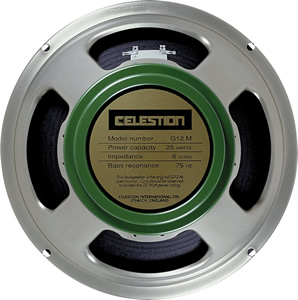
Power Handling 25W (!)
Impedance 8 / 16 Ohm
Sensitivity (1W @ 1m) 97dB
Resonant Frequency 75Hz
Frequency Response 75Hz - 5kHz
Magnet Weight 35oz
Virtually the same speaker but very low power handling!!! (yikes!).
What does that mean? cheaper cone? thinner coil wire?
flimsier glue? crappier magnet? all of the above?
I suppose guitarists like it because it breaks up sooner or distorts in some controllable fashion.
Nothing that can't be reproduced by an amp simulator and/or EQ, so why pay more for less?
Again, these look useless for bass, however.
The idea of paying more for the 'sound' of the cheap 25watt version of the same speaker
seems like the scam of the century!
No wonder the Chinese are making more money than the Americans.
I'm thinking once again that these speakers are so "popular",
because Marshall sticks them in their cabinets to save boatloads of money,
sloughing off cheap crap to consumers.
Branding works.
Also, two versions of the same speaker go a long way explaining the mixed reviews,
and weakness of the 'easy-to-blow' Celestions.
The good Celestions go in the rigs that advertise the product,
while the cheap shiite goes into the consumer model.
Buyer beware!
Even four 12" 'Celestions' in a Marshall cab might only be able to handle 100 watts max!!!
For that result, might as well steal four TV speakers, or two sets of stereo woofers from the pawn shop.
Even a 'good' set can only handle 300 watts, and only if you trust the rating!
although you can pick them up on Ebay used for as little as $60-75 (plus expensive shipping):
G12T-75

has these specs:
Power Handling: 75W
Impedance: 8 or 16 Ohms
Sensitivity (1W @ 1m): 97dB
Resonant Frequency: 75Hz
Frequency Response: 75Hz - 5kHz
Magnet Weight: 35 oz
Country of Origin: China
Shipping Weight: 9 lbs
So really these are Chinese-made (not USA), and overpriced/rated.
-----------------------------
The Celestion Greenback
seems to be on sale as 'cheap' as
$125.00

Power Handling 25W (!)
Impedance 8 / 16 Ohm
Sensitivity (1W @ 1m) 97dB
Resonant Frequency 75Hz
Frequency Response 75Hz - 5kHz
Magnet Weight 35oz
Virtually the same speaker but very low power handling!!! (yikes!).
What does that mean? cheaper cone? thinner coil wire?
flimsier glue? crappier magnet? all of the above?
I suppose guitarists like it because it breaks up sooner or distorts in some controllable fashion.
Nothing that can't be reproduced by an amp simulator and/or EQ, so why pay more for less?
Again, these look useless for bass, however.
The idea of paying more for the 'sound' of the cheap 25watt version of the same speaker
seems like the scam of the century!
No wonder the Chinese are making more money than the Americans.
I'm thinking once again that these speakers are so "popular",
because Marshall sticks them in their cabinets to save boatloads of money,
sloughing off cheap crap to consumers.
Branding works.
Also, two versions of the same speaker go a long way explaining the mixed reviews,
and weakness of the 'easy-to-blow' Celestions.
The good Celestions go in the rigs that advertise the product,
while the cheap shiite goes into the consumer model.
Buyer beware!
Even four 12" 'Celestions' in a Marshall cab might only be able to handle 100 watts max!!!
For that result, might as well steal four TV speakers, or two sets of stereo woofers from the pawn shop.
Even a 'good' set can only handle 300 watts, and only if you trust the rating!
Last edited:
ok. Most instrument speakers from the 60s to present day, including PA use linen or cloth pleated surrounds. Some guitar drivers use a single paper pleat, but ive found these rare as...i have an 8" guitar speaker like this, but the most popular or well knon dont use a paper surround. A cloth surround on a guitar speaker doesnt make it suitable for bass guitar duty, it will just sound like a guitbass, like the presidents of usa. Thats not a BAD thing. Only trouble is basschords will easily overdrive them. If it were my project then id use guit speakers, maybe a hp filter for protection, and just build a 15 inch cab to sit the guit one on top. Like the 4x10 and 15 bass rigs, the guit cab will have the tone to show the character of the instrument, while the 15 will take care of the real bass duty.
Lol power handling of 25w is enough, its not the same as other celestions, trust me. Search the blueback if u want a shock! Im running 4x10 greens and a 120w dean markley valve head. I get my voice and eyeballs buzzing on less than half volume
Lol power handling of 25w is enough, its not the same as other celestions, trust me. Search the blueback if u want a shock! Im running 4x10 greens and a 120w dean markley valve head. I get my voice and eyeballs buzzing on less than half volume
Last edited:
ok. Most instrument speakers ... use cloth surrounds. ... A guitar speaker... will just sound like a guitbass. ... Only trouble is basschords will easily overdrive them.
Another reason not to try to use them for bass,
if you want the freedom to play anything, any style...
Obviously this won't be true for bass.Lol power handling of 25w is enough, its not the same as other celestions, trust me. Search the blueback if u want a shock! Im running 4x10 greens and a 120w dean markley valve head. I get my voice and eyeballs buzzing on less than half volume
As someone pointed out, even marginally less sensitive speakers (i.e. bass speakers) will require far more power,
and you have to double the air-movement or excursion for each octave, multiplying the actual power needed by x 16 (?) or so...
So to do that with a bass means more like a 300-600 watt amp, and for a safety margin, say at least 300-500 watt speakers...
--------------------------------------------------------
Celestion Vintage 30
$145 each sale price.... (x 4 = $600 !!! no bargains here)...
hmmm.... according to this discussion, the V-30 is Celestion's own high power version of the Blueback, so why bother?
Might as well let Celestion give us their best version of the same sound.
Also, ask yourself: Why did they feel they needed to copy the exact same sound,
but only as a 60 watt version?
- Because even for guitar, 240 watts was deemed some kind of minimum rating,
for warrantee and support purposes. They ain't gonna refund money to a bunch of airheads,
who take 15-25 watt speakers and pump in 100 watts per cabinet.
An externally hosted image should be here but it was not working when we last tested it.
This looks like a 'cover your ***' engineering and marketing decision.
- Tone of Celestion Blue with more power handling
- 60W power rating (handling 3 times the power)
- 100db sensitivity (needing less power too)
- Round copper voice coil (cheap coil)
- Ceramic magnet (cheap magnet)
- 70-5kHz frequency range (same range).
Get a better price-point in USA-made speaker!
Keep jobs here, and quit giving your hard earned cash to the Chinese,
who need your money like a hole in the head....
Last edited:
- Status
- Not open for further replies.
- Home
- Loudspeakers
- Full Range
- Homemade Marshall cabinet - how to port? what speakers?
